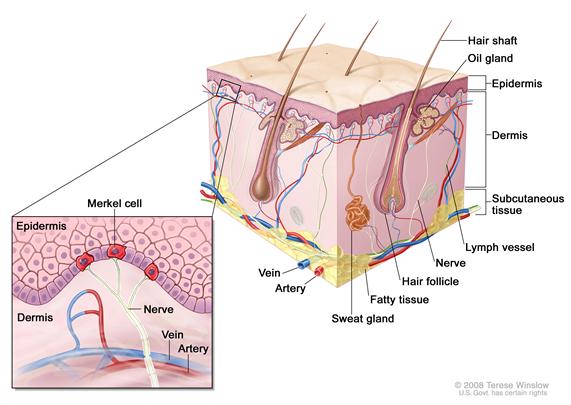General Information About Merkel Cell Carcinoma
Key Points for This Section
- Merkel cell carcinoma is a very rare disease in which malignant (cancer) cells form in the skin.
- Sun exposure and having a weak immune system can affect the risk of developing Merkel cell carcinoma.
- Merkel cell carcinoma usually appears as a single painless lump on sun-exposed skin.
- Tests and procedures that examine the skin are used to detect (find) and diagnose Merkel cell carcinoma.
- Certain factors affect prognosis (chance of recovery) and treatment options.
Merkel cell carcinoma is a very rare disease in which malignant (cancer) cells form in the skin.
Merkel cells are found in the top layer of the skin. These cells are very close to the nerve endings that receive the sensation of touch. Merkel cell carcinoma, also called neuroendocrine carcinoma of the skin or trabecular cancer, is a very rare type of skin cancer that forms when Merkel cells grow out of control. Merkel cell carcinoma starts most often in areas of skin exposed to the sun, especially the head and neck, as well as the arms, legs, and trunk.

Merkel cell carcinoma tends to grow quickly and to metastasize (spread) at an early stage. It usually spreads first to nearby lymph nodes and then may spread to lymph nodes or skin in distant parts of the body, lungs, brain, bones, or other organs.
Sun exposure and having a weak immune system can affect the risk of developing Merkel cell carcinoma.
Anything that increases your risk of getting a disease is called a risk factor. Having a risk factor does not mean that you will get cancer; not having risk factors doesn't mean that you will not get cancer. People who think they may be at risk should discuss this with their doctor. Risk factors for Merkel cell carcinoma include the following:
- Being exposed to a lot of natural sunlight.
- Being exposed to artificial sunlight, such as from tanning beds or psoralen and ultraviolet A (PUVA) therapy for psoriasis.
- Having an immune system weakened by disease, such as chronic lymphocytic leukemia or HIV infection.
- Taking drugs that make the immune system less active, such as after an organ transplant.
- Having a history of other types of cancer.
- Being older than 50 years, male, or white.
Merkel cell carcinoma usually appears as a single painless lump on sun-exposed skin.
This and other changes in the skin may be caused by Merkel cell carcinoma. Other conditions may cause the same symptoms. A doctor should be consulted if changes in the skin are seen.
Merkel cell carcinoma usually appears on sun-exposed skin as a single lump that is:
- Fast-growing.
- Painless.
- Firm and dome-shaped or raised.
- Red or violet in color.
Tests and procedures that examine the skin are used to detect (find) and diagnose Merkel cell carcinoma.
The following tests and procedures may be used:
- Physical exam and history: An exam of the body to check general signs of health, including checking for signs of disease, such as lumps or anything else that seems unusual. A history of the patient’s health habits and past illnesses and treatments will also be taken.
- Full-body skin exam: A doctor or nurse checks the skin for bumps or spots that look abnormal in color, size, shape, or texture. The size, shape, and texture of the lymph nodes will also be checked.
- Biopsy: The removal of cells or tissues so they can be viewed under a microscope by a pathologist to check for signs of cancer.
Certain factors affect prognosis (chance of recovery) and treatment options.
The prognosis (chance of recovery) and treatment options depend on the following:
- The stage of the cancer (the size of the tumor and whether it has spread to the lymph nodes or other parts of the body).
- Where the cancer is in the body.
- Whether the cancer has just been diagnosed or has recurred (come back).
- The patient's age and general health.
Prognosis also depends on how deeply the tumor has grown into the skin.


 Back to Top
Back to Top